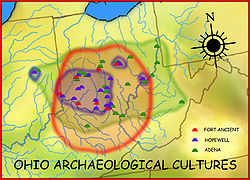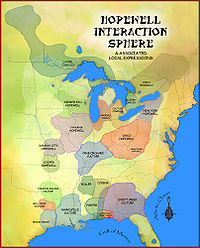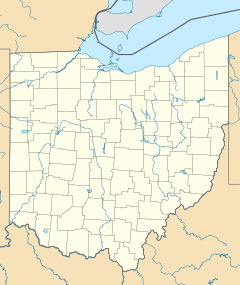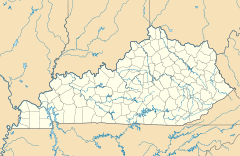- Portsmouth Earthworks
-
Horseshoe Mound
Location: Scioto County, Ohio Nearest city: Portsmouth, Ohio Coordinates: 38°44′35.70″N 82°58′38.39″W / 38.74325°N 82.9773306°WCoordinates: 38°44′35.70″N 82°58′38.39″W / 38.74325°N 82.9773306°W Built: 499-0 BCE, 499-0 CE, 1000-500 CE Governing body: Local Government NRHP Reference#: 74001621 Added to NRHP: 1974[1] The Portsmouth Earthworks are a large prehistoric mound complex constructed by the Ohio Hopewell culture mound builder indigenous peoples of eastern North America (100 BCE to 500 CE).[2] The site was one of the largest earthwork ceremonial centers constructed by the Hopewell and is located at the confluence of the Scioto and Ohio Rivers, in present day Ohio.
The majority of the mound complex site is now covered by the city of Portsmouth in Scioto County, Ohio.[2] Several individual sections of the complex have been included on the National Register of Historic Places.
Contents
Description
Originally, the Portsmouth Earthworks consisted of three sections extending over twenty miles of the Ohio River valley, crossing from Ohio to Kentucky in several places. It was surveyed and mapped by E. G. Squier in 1847 for inclusion in the seminal archaeological and anthrolopological work Ancient Monuments of the Mississippi Valley.[3]
Portsmouth Earthworks, Group B
The northern most section was made up of a number of circular enclosures, two large horseshoe-shaped enclosures, and three sets of parallel-walled roads leading away in different directions. One set of walled roads extends across the Ohio River into South Portsmouth, Kentucky to the southwest to Portsmouth Earthworks, Group A. Another set of walled roads lead to the southeast where it also crossed the Ohio River and lead to Portsmouth Earthworks, Group C.[3] The third set of walled roads lead to the northwest for an undetermined distance, and may point to Tremper Mound and Works, some 5 miles away. The City of Portsmouth maintains a public park which includes one of the remaining horseshoe-shaped enclosures, known as Mound Park, it is the only publicly accessible part of the complex.[2] Under the name Horseshoe Mound it was listed on the National Register of Historic Places in 1974.[2]
Portsmouth Earthworks, Group A
Portsmouth Earthworks, Group ALocation: Greenup County, Kentucky Nearest city: South Portsmouth Coordinates: 38°43′17.76″N 83°1′22.98″W / 38.7216°N 83.02305°WCoordinates: 38°43′17.76″N 83°1′22.98″W / 38.7216°N 83.02305°W Built: 499-0 BCE, 499-0 CE, 1000-500 CE, 1499-1000 CE, 1749-1500 CE, 1750-1799 CE Governing body: Private NRHP Reference#: 80001534[1] Added to NRHP: December 4, 1980 Also known as the Old Fort Earthworks (15Gp1) it is a series of rectangular enclosures near South Portsmouth in Greenup County, Kentucky. Group A is a large square enclosure with two series of parallel walls extending from the northeast and southwest corners. The Old Fort Earthworks consist of several sites, including the Old Fort Earthworks (15Gp1), Mays Mound (15Gp16), Hicks Mound (15Gp265), Stephenson Mound (15Lw139), and several other unnamed mounds and enclosures. It is also the location of Lower Shawneetown, a protohistoric/historic Fort Ancient and Shawnee settlement and colonial trading post which are all part of the Lower Shawneetown Archeological District,[4] along with the Thompson and Hansen Sites
Portsmouth Earthworks, Group C
Also known as the Biggs Site (15Gp8), Group C was a large series of concentric circles surrounding a central cone mound, believed to have been built by the Adena culture. This section of the earthworks is located in Greenup County, Kentucky several miles to the east of South Shore, but connected to Group B by a causeway.
Gallery of Squier and Davis maps
See also
- List of Hopewell sites
References
- ^ a b "National Register Information System". National Register of Historic Places. National Park Service. 2009-03-13. http://nrhp.focus.nps.gov/natreghome.do?searchtype=natreghome.
- ^ a b c d "Portsmouth Earthworks-Ohio History Central". http://www.ohiohistorycentral.org/entry.php?rec=2222. Retrieved 2009-06-06.
- ^ a b E. G. Squier and E. H. Davis (1848). Ancient Monuments of the Mississippi Valley. Smithsonian Institution.
- ^ Applegate, Darlene (2008), "Chapter 5:Woodland period", in Pollack, David, The Archaeology of Kentucky:an update, 1, Kentucky Heritage Council, pp. 524–525, ISBN 9781934492284, http://heritage.ky.gov/NR/rdonlyres/7FD10722-66D5-4987-A3A3-19A6E27BCFA0/0/TheArchaeologyofKentuckyAnUpdateVolume1NEW.pdf
External links
List of Adena culture sites · Woodland period · Mound builder (people) · List of archaeological periods (North America)Ohio Sites Adena Mound · Austin Brown Mound · Arledge Mounds I and II · Beam Farm · Clemmons Mound · Conrad Mound Archeological Site · Coon Hunters Mound · George Deffenbaugh Mound · Enon Mound · Fortner Mounds · Great Mound · Highbanks Metropolitan Park Mounds I and II · Hillside Haven Mound · Hodgen's Cemetery Mound · Horn Mound · Hurley Mound · Jackson Mound · Karshner Mound · Kinzer Mound · Luthor List Mound · Miamisburg Mound · Odd Fellows' Cemetery Mound · Old Maid's Orchard Mound · Orators Mound · Carl Potter Mound · Reeves Mound · D.S. Rose Mound · Ross Trails Adena Circle · Short Woods Park Mound · Snead Mound · Spruce Run Earthworks · David Stitt Mound · Story Mound (Cincinnati) · Story Mound (Chillicothe) · Wolf Plains Group · Zaleski Mound Group
Kentucky Sites West Virginia Sites Indiana Sites Related topics · Ancient Monuments of the Mississippi Valley · burial mound · Eastern Agricultural Complex · Hopewell tradition Hopewellian peoplesWoodland period · List of Hopewell sites · Mound builder (people) · List of archaeological periods (North America)
Hopewellian peoplesWoodland period · List of Hopewell sites · Mound builder (people) · List of archaeological periods (North America)Ohio Hopewell Beam Farm · Benham Mound · Cary Village Site · Cedar-Bank Works · Dunns Pond Mound · Ellis Mounds · Ety Enclosure · Ety Habitation Site · Fort Ancient · Fortified Hill Works · Great Hopewell Road · High Banks Works · Hopeton Earthworks · Hopewell Culture National Historical Park · Indian Mound Cemetery · Keiter Mound · Marietta Earthworks · Moorehead Circle · Mound of Pipes · Nettle Lake Mound Group · Newark Earthworks · Oak Mounds · Perin Village Site · Portsmouth Earthworks · Seip Earthworks and Dill Mounds District · Shawnee Lookout · Tremper Mound and Works · Williamson Mound Archeological District
Crab Orchard culture Goodall Focus Goodall Site · Norton Mound GroupHavana Hopewell culture Kansas City Hopewell Marksville culture Miller culture Point Peninsula Complex Swift Creek culture Etowah Indian Mounds · Leake Mounds · Kolomoki Mounds Historic Park · Miner's Creek site, · Nacoochee Mound · Swift Creek mound site · Yearwood siteOther Hopewellian peoples Armstrong culture · Copena culture · Fourche Maline culture · Laurel Complex · Saugeen Complex · Old Stone Fort (Tennessee)Exotic trade items Related topics · Ancient Monuments of the Mississippi Valley · Black drink · burial mound · Calumet (pipe) · Effigy mound · Hopewell pottery · Horned Serpent · Eastern Agricultural Complex · Underwater pantherU.S. National Register of Historic Places Topics Lists by states Alabama • Alaska • Arizona • Arkansas • California • Colorado • Connecticut • Delaware • Florida • Georgia • Hawaii • Idaho • Illinois • Indiana • Iowa • Kansas • Kentucky • Louisiana • Maine • Maryland • Massachusetts • Michigan • Minnesota • Mississippi • Missouri • Montana • Nebraska • Nevada • New Hampshire • New Jersey • New Mexico • New York • North Carolina • North Dakota • Ohio • Oklahoma • Oregon • Pennsylvania • Rhode Island • South Carolina • South Dakota • Tennessee • Texas • Utah • Vermont • Virginia • Washington • West Virginia • Wisconsin • WyomingLists by territories Lists by associated states Other Categories:- Adena culture
- Ohio Hopewell
- Fort Ancient culture
- Native American history of Kentucky
- Native American archeology
- Archaeological sites in Kentucky
- Archaeological sites on the National Register of Historic Places in Kentucky
- Archaeological sites on the National Register of Historic Places in Ohio
- Geography of Scioto County, Ohio
- Buildings and structures in Greenup County, Kentucky
- Mounds in the United States
Wikimedia Foundation. 2010.







